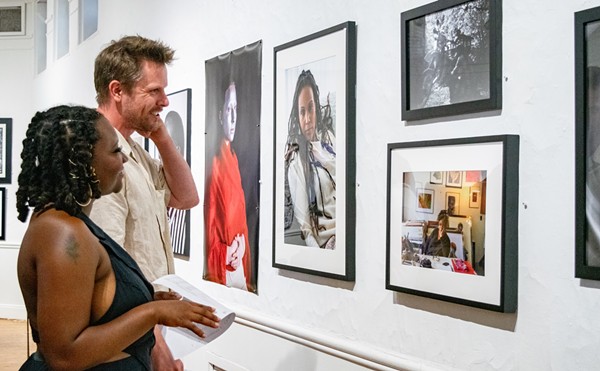The Farnsworth entrance of the Detroit Institute of Arts echoes with countless memories. Up-and-coming art curator Aaron Timlin, who last week took over as executive director of the Detroit Artists’ Market, can remember walking through these doors as a child to see art.
Timlin’s dad, sculptor Hugh Timlin, would always bring the kids with him when he came to look at the DIA’s treasures. Aaron recalls standing around for 10 or 15 minutes at a time, wondering how long dad was going to stare at one painting: “I was thinking, ‘Come on, let’s get going, there’s so much else to see.’”
Detroit art-scenesters know the younger Timlin as a man who can think (and do) the unthinkable. In 1998, he renovated an ancient commercial building at 5141 Rosa Parks Blvd., west of Wayne State University in a neighborhood completely off the beaten path, and founded detroit contemporary there. The gallery-performance space soon became known for its expansive approach to exhibitions, techno concerts and all manner of edgy performance. And Timlin quickly extended his embrace to the surrounding community in the form of art classes for kids and never-say-too-busy mentoring.
Then in the summer of 2000, Timlin walked from Detroit to New York City in 48 days, with a large white cardboard box over his head and torso. On the outside, in black letters, were the words “Got art?” The often-grueling trek was a fund-raising effort for detroit contemporary’s art classes and demonstrated this young man’s uncommon commitment to his projects.
Now at 31, Timlin takes over the reins of the Detroit Artists’ Market, founded in 1932, which is one of the city’s venerable art sites. His task will be to revitalize and reorient a gallery that sometimes has seemed stuck on idle. Metro Times invited him to tour the DIA’s modern art collection, to get his personal take on its focal points and installation, this from someone who has been visiting the museum virtually all his life.
From childhood outings to the DIA to a short stint as a museum volunteer in the late ’90s (“I loved helping out, relating to the visitors and seeing the art all day”), Timlin has always put a high value on this hallowed place. But as we enter the pop art room of the modern art collection in the north wing, he has an immediate reaction:
“It’s too crowded — I don’t remember it being this crowded before they redid this space. It has to do with line of sight — I know when hanging a show you’re not going to be able to avoid obstruction from every angle, but at least coming into a space, you should be able to see everything clearly, without sculptures getting in the way of the paintings.
“And look at that,” he says, pointing out Claes Oldenburg’s Giant Three-Way Plug, a huge over-scaled three-way electric plug made of mahogany veneer over wood. “It wasn’t hung like that before, over an information table — it was off in a corner by itself in a bigger gallery. I wouldn’t put that education table under it since they have a whole education area a few rooms away … it’s really disappointing, as if the Oldenburg was just some kind of ornate decoration.
“I remember years ago coming here on a Sunday afternoon. I’d sit on a bench and just look at these paintings in a big room where they were spaced out nicely … just sit there and relax and look … I don’t see that happening now.”
The reinstallation of the modern galleries, completed in summer and fall of 1998, included the controversial covering of a beautiful wood-parquet floor with gray paint and an even more problematic “packing” of the galleries with works.
“At first, when I saw the new installation, I felt like they still weren’t done,” says Timlin. “It seemed like they were just keeping everything here, so that we could at least see the art, like in a holding area, but that they planned to reinstall it elsewhere … in the new addition perhaps.”
According to DIA public relations manager Pamela Marcil, the new south wing addition (which should be completed within two years), will contain special exhibition space, the Gibbs Learning Center and “expanded gallery space for the permanent collection.” But Marcil adds that no decisions have been made as to which parts of the present collection will be affected.
As Timlin points out the ever-present information signage and the way a large study hall shares visual space with a room of minimalist works by Ellsworth Kelly, Donald Judd and Frank Stella, he sounds another unhappy note:
“Each label stanchion intrudes on the work, so it’s not an experience anymore. Each work isn’t part of a journey anymore — it’s a page in a book. And I always thought of the modern collection as a journey for the mind … just walking through this space and then going back outside and having my world change for a moment.
“The signage is so distracting — if they just tried it, if they just moved all these signs out, or at least put them on the wall and made them the color of the wall …
“I remember the old minimalist room. It was like a temple, a retreat space where I could go, like a little hideout in the park, because I always thought of the DIA as a park. But this room doesn’t do that anymore, with the way the study area butts up against it.”
We walk into the modern European galleries, with their Matisses and Picassos, and Timlin brightens up.
“These rooms are much better than the ones before. In my memory, the older ones were pretty dark and now you can really see these pieces.”
As we enter a gallery devoted to Detroit’s Cass Corridor artists — with pieces by Robert Sestock, Cay Bahnmiller, Gordon Newton, Ann Mikolowski and Michael Luchs — Timlin notices a single straight-backed chair sitting in the middle of the floor.
“Look at that ugly chair. Before, with the wooden benches that they had in these galleries, you could pivot and move around. Where’s that chair directing you? To one piece. And then to see something else you have to move the whole chair. How many people can sit in this room, look at the art and meditate? One person. But with a long bench with no back, it was a lot easier, though I don’t see any of those in this whole wing.”
Is Timlin disappointed overall in the DIA? “Not overall,” he says emphatically. “But I hope the modern installation is just temporary … I really hope so.”
As we head out toward the Woodward entrance, we pass through the courtyard containing the magnificent Diego Rivera murals, with its space and light and lack of obtrusive signage. We agree that it seems to provide a model of how art should be displayed.
“It’s an ideal example,” says Timlin, “of how to do it right. That Oldenburg plug in the pop art room should also have its own space, like it used to, and be an awesome thing for kids to see when they walk in and say ‘Wow!’ Before, when I’d bring my siblings when they were little to see the modern art and show them the things that were ‘wow’ to me, I’d watch them go ‘wow’ — it was so fun. I don’t think there’d be that many ‘wows’ over there now.”

This is the first in a series of visits in which curators from alternative art spaces take a critical look at major regional art centers. Be sure to read the others:
• "Art at the border" (4/10/02) — Artcite’s Christine Burchnal challenges the Art Gallery of Windsor.
• "Epiphany in Treetown" (4/17/02) — Painter and curator Jocelyn Rainey finds heaven at the U of M Museum of Art.
• "Minding the art" (4/24/02) — CCS instructor and Tangent Gallery curator Mitch Cope explores the diverse and challenging works displayed at Cranbrook Art Museum.

In another related feature, Vincent Carducci reviews a new book chronicling a legacy of short-sightedness and hubris in managing the Detroit Institute of Arts.
George Tysh is arts editor of Metro Times. E-mail [email protected]




